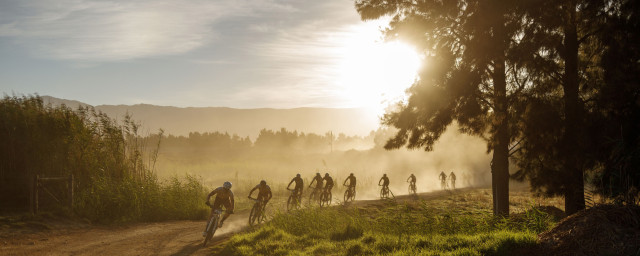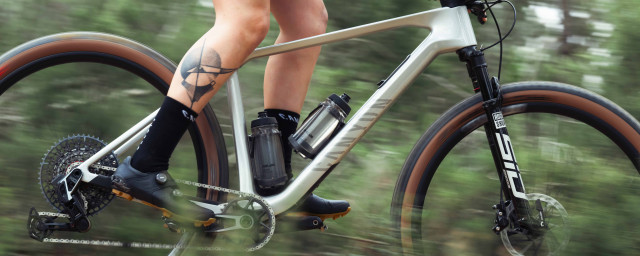Enduro mountain biking - everything you need to know

Enduro mountain biking is taking the world by storm as it’s offering competitive racing for all levels of riders. The best bit is that it can be very similar to your Sunday ride, but with timing chips and taped trails. You can even check out off-road.cc's own enduro antics and Meet Team ORCC - off-road.cc's very own amateur race team.
- Big Read: Racing after lockdown - Liam's Ex Enduro diary
- The best enduro full face helmets you can buy - tried and tested
- Big Read: Big mountain pairs racing with Enduro2 Les Arcs
What is enduro mountain biking?
Enduro can be likened to a blend of downhill and cross country mountain bike racing as competitors face multiple timed downhill stages but after a stage is completed, riders are required to get to the next stage often under their own steam. These sections are referred to as ‘transitions’ or ‘liaisons’. However, the time at which a transition is completed doesn’t affect the final result. Only the timed downhill stages count towards this.
At certain venues or events, transitions may be replaced with an uplift but according to Enduro World Series (EWS ) rules, every venue should have at least one pedal-powered transition. Of course, these rules don’t apply to every series.
Enduro races can take place over anywhere from one to three days, with events like the Trans Madeira taking a full 5 days. As for stages, there can be four up to seven or eight timed stages, that's ignoring the big ones, like Trans Madeira, which has give or take 30 stages.
Stages and events vary in difficulty level but enduro can get so extreme that it uses full downhill racetracks, or sections, as single stages. As such, enduro can become incredibly demanding for the body and bike as riders then need to pedal to the next stage while remaining competitive where it matters over multiple stages.
Mash-Up Enduro
One of the best things about enduro is that it’s an incredibly welcoming scene where organisers offer events tailored especially to those who are new to racing, or those who want a taste of life between the tapes but would rather pedal around with their mates. A common format of enduro designed to appeal to everyone is the mash-up enduro.
Mash-up enduros often include fewer stages but each stage can be attempted as many times as the rider likes. The downside is that there are no untimed practice sessions, so every run counts.
Why is enduro so great?
The main reason why enduro has picked up exponential traction and is continuing to do so is its accessibility to all levels of rider. Unlike downhill, where riders require ridiculous skill and bravery and cross country where extreme fitness is key, anyone can find an enduro race that suits them and have a great time in the woods with their mates.
It’s also accurately reflective of a lot of people’s Sunday trail rides, where people pedal to a downhill trail, shred, and then pedal to the next one. Along with that, enduro is incredibly welcoming with mash-up race formats and many events catering to not only the elites but those who are looking to dip their toes into competitive riding. You can even enter races such as the EWS 100 or 80 which runs alongside many EWS races, where you'll rub shoulders with the pros and race on either 100% or 80% of an EWS venue. Often, alongside your usual age categories (Senior, Master, Veteran, etc) there's a fun category for those who want to take things a little less seriously.
Unlike cross country and downhill, you don't need a bike that's designed specifically for enduro (while it can help a little). You can ride the very same bike that you use for your usual rides and still nab a podium.
High-level enduro racing, such as EWS isn't televised like cross country or downhill but interest is quickly growing. Thanks to some big personalities such as Jesse Melamed and Yoann Barelli, enduro has a huge appeal on YouTube. Through rider's YouTube channels, you can check out full race runs as well as tap into these people's wealth of riding knowledge.
What bike is the best for enduro mountain biking?
The beauty of enduro is that races can be attempted on any kind of bike, some events even have different bike categories, especially for hardtails and e-bikes (with an e-bike-specific stage). However, at the top of the sport, riders opt for bikes with aggressive geometries and lots of suspension travel.
Using Canyon’s 2022 Strive CFR for example, a bike designed especially for enduro, it comes with 170mm of travel at the front and 160mm at the rear. A large frame then gets a whopping 500mm reach with a very slack 63-degree head tube angle and a steep 76.8-degree seat tube angle.
These angles have been chosen to create a bike that’s comfortable to pedal up a hill, as of course that’s a large part of enduro but the bike also has to be confident, stable and lightning-fast downhill, where riders are timed. This bike specifically goes deep into blending a pedal-friendly but fast downhill bike, as it comes with fancy tech that limits suspension travel at the rear and steepens its geometry to make it more efficient at the flick of a switch. However, it’s not all about big travel bikes as some riders opt for less travel at the rear for efficiency.
While enduro stages are primarily downhill, it’s common to find short but steep climbs mid-stage. So bikes must pedal efficiently to help get to the end of the stage as quickly as possible, without sapping too much of the rider’s energy.
It can be argued that enduro is directly responsible for recent advances in suspension platform design, making it possible to pedal bikes with big suspension travel uphill with ease.
What do I need to race enduro mountain biking?
Before anything, you’ll need to buy your race entry. Prices can range from £50 right up to a few hundred pounds depending on the race you choose. Often, there aren't any entry requirements unless you're looking to race with the best at an EWS race, where you'll need enough qualification points to get in.
Once your entry has been purchased, you’ll need to check your chosen race’s rules for any requirements that are specific to that event. For example, it’s written in the EWS rules that riders must wear a full-face helmet, while at lower level races, full face hats are entirely optional. Either way, helmets are essential and it’s wise to wear knee and elbow pads, and eyewear.
Most enduro races require riders to be entirely self-sufficient, so you’ll need to carry enough food and water to keep yourself energized and hydrated throughout the day. If it’s a multi-day event you’re racing, you’ll need to sort out your own accommodation, unless the event states otherwise.
A lot of events take riders kilometres away from the event village so you’ll need to be properly equipped to repair your bike in case of a mechanical. At the very least you’ll need to carry a method of tyre repair and inflation, as well as a multitool with a chain tool and an innertube. You’ll also need to consider how to carry that kit too. See our 13 ways to attach kit to your bike for some handy hints on that subject.
Enduro mountain biking events to try in the UK
Enduro is incredibly popular in the UK with multiple series and events held across the island. Each is unique to an area and ranges in difficulty. Here are but a few of the events you can enter in the UK.
Southern Enduro Series
The Southern Enduro Series is made up of several enduro races which can be entered individually or as a series. In 2022, the Southern Enduro series has spanned from the Queen Elizabeth Central Park, all the way to Plymouth with a Champs round in Minehead.
This series caters to everyone with a relatively easygoing atmosphere at all races, whereas the Champs round gets serious as it's a national round with steeper and more technical trails.
PMBA Enduro Series
The PMBA Enduro Series is based in the north of the country with the aim of "enduro is for all". This series is the only one in the country with events in England, Wales, and Scotland. Races are held at Llangollen, a downhill venue, Gisburn and Kirroughtree.
Welsh Enduro Series
As with others we've covered, the Welsh Enduro Series offers something not only for experienced competitors but for those looking to start their enduro journey. Events are held at Dyfi, Foel Gasnach and Lladegla, amongst other venues.
Scottish Enduro Series
This one is made up of fewer races but a couple of them double up as EWS qualifiers for those looking to take their racing to the next level. The Scottish Enduro Series takes riders to the Nevis Range, Pitfichie and Tweed Valley.
The EX Enduro
It's not all about series events, however, as there are staples on the enduro calendar such as Merida's EX Enduro which takes place over three days with around 120km of riding over 21 stages. The EX Enduro offers an all-inclusive experience with breakfast, dinner, camping, and yoga thrown in.















